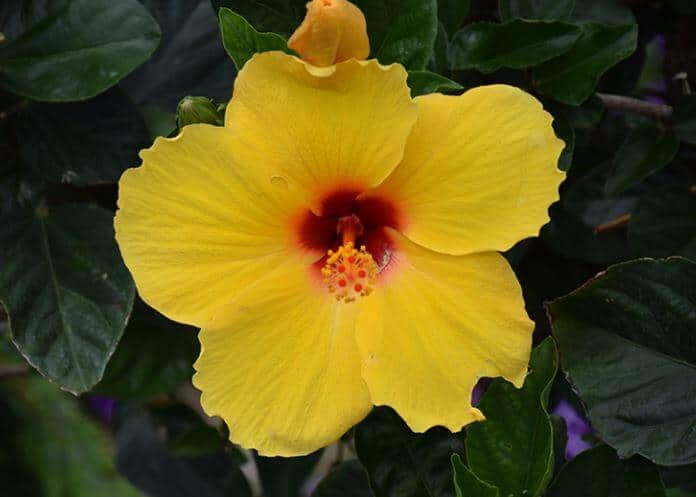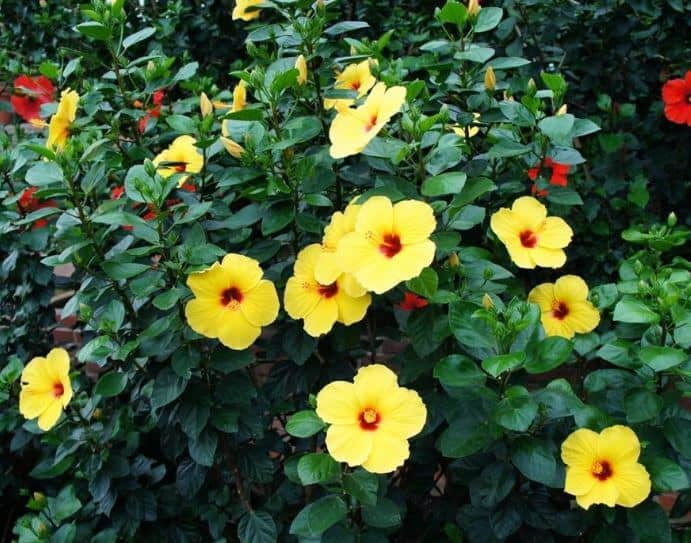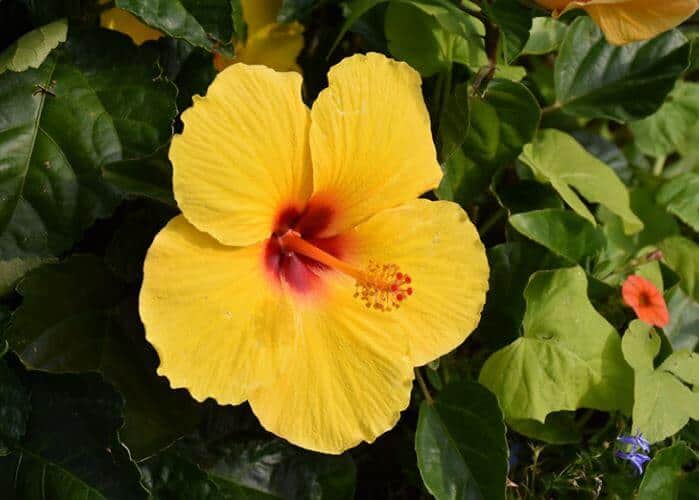Last Updated on April 5, 2023 by a Friendly Gardener
If you like showy flowering plants that also do well in pots, the tropical hibiscuses of the Malvaceae family are a perfect choice. Among these, boasting exotic blossoms shaped like trumpets in varying sizes and colors, the hibiscus rosa-sinensis known as the “Sunny Wind” is a striking houseplant.
This plant belongs to a group of Hibiscus known as the Trade Winds Hibiscus that features a compact growth habit. Foliage is deep green, and pointy with a glossy appearance. The leaves will remain throughout the winter season. Blooms come in a bright shade of yellow with red centers that create a burst of color from the middle of summer through to the beginning of autumn when cultivated indoors.
The Sunny Wind hibiscus is a dwarf species of plant that generally stays compact and grows slowly. Some can reach heights of six feet and spread of as much as four feet, in which case they are often employed in garden landscaping as hedges to maintain privacy. The Sunny Wind hibiscus will average 2.5 feet, making it a lovely houseplant or patio and porch decoration with blooms that can grow to be six to seven inches.
Sunny Wind Hibiscus Plant Care

The Sunny Wind is an evergreen plant that is multi-stemmed: Its spreading habit will develop in an upright position. With proper care and environmental conditions, it can be expected to enjoy a comfortably long lifespan. One great feature of the Sunny Wind is its pollution tolerance, so if you live in a city dwelling with a nice balcony, this plant is a terrific option.
Soil
Soil needs to be well-draining and should not be allowed to completely dry out. A basic good quality potting soil rich in organic matter will more than suffice. It does not have a particular soil pH preference but will thrive in soils ranging from a mildly acidic 6 to a neutral 7.5. Consider adding some perlite to container soil to guarantee drainage.
When growing in a garden bed, place your plants a minimum of three feet apart for good air circulation.
Light

You may think that a tropical species like the hibiscus prefers full sun, but this isn’t necessarily the case. In northern regions, it will thrive in full sun exposure, but in dry, hot environments, this hibiscus can do with some partial shade, especially in the afternoon. The plant itself will hint at what it likes. If it is producing lots of blooms, leave it where it is. If it is not budding or flowering, relocate it to a spot with more access to sunlight. Outdoor plants can flower year-round.
When cultivating indoors, it will need exposure to bright light, and indoor lighting alone may be insufficient for this plant’s needs. Indoor plants will generally bloom from spring to autumn.
Water
The Sunny Wind is a thirsty creature, and you should be aware that your hibiscus will not produce blooms unless it gets enough water. The proper amount will be influenced by the amount of heat and humidity in the environment as well as wind. This plant may need to be watered daily, and if you live in an arid climate, you may need to water it twice daily. Hibiscus plants generally count on one to two inches of water weekly. Container plants will also need more water than garden plants.
Should your hibiscus produce yellowing leaves at its top or drop foliage it may not be receiving sufficient water. If instead, leaves are yellowing at the bottom of the plant or in the middle, chances are it is drowning in excess water.
Humidity
The Sunny Wind hibiscus prefers high humidity. Regular misting, a space humidifier, or a pebble tray can help.
Temperature
As a tropical plant, this hibiscus loves year-round warm climates, however, in cooler climates it may be grown as an annual, or in a container. With container cultivation, it can be brought inside, and then returned outside once winter has passed. The environmental climate will influence its growth habit. So, a six-foot hedge found in a warmer climate should not be expected from a Sunny Wind cultivated as an annual or in a container.
The Sunny Wind Hibiscus likes a daytime temperature between 75° and 85° F. It can be cultivated in USDA hardiness zones 9 through 11. Nighttime temps should not fall below 50°F. as buds will not develop.
If temperatures are on the cooler side, place a layer of thick mulch over the plant’s root area for added winter protection outdoors. Beware, they are frost-tender. If outdoor temperatures drop below 60°F, your plant should be overwintered.
Feeding
Liquid fertilizer is the recommended choice for a tropical hibiscus. Ideally, nitrate should be in the mix. Select a fertilizer with an NPK of 20-10-20 to apply weekly in the spring and summer.
Pruning

The Hibiscus Sunny Wind will need some maintenance. Pruning is important for the plant to keep its shape. Stems should be trimmed back to half at the beginning of spring with approximately one-third of older woody stems being removed.
Sunny Wind Hibiscus Potting and Repotting
These plants tend to produce more flowers if they are a little bit root bound. Plan on repotting a container hibiscus every other year. Repot at the beginning of spring when dormancy is finished but before flowering begins. If you do not find a need to repot, provide your plant with fresh soil after two years.
Sunny Wind Hibiscus Propagation

Propagation can be accomplished using stem cuttings or from seed. To propagate from stem cuttings, cut 4 to 6-inch segments and remove all leaves except at the top of the cutting. Cover the cut end in rooting hormone and place in moistened potting soil. Place your cuttings in a warm sunny location with good humidity until new growth develops.
Sunny Wind Hibiscus Problems
Expect to have visiting hummingbirds and butterflies in your garden if you plant this hibiscus. Luckily, it is not appealing to local wildlife like deer, so your garden should remain intact. Its principal problems will relate to over or underwatering and proper sunlight exposure.
Nonetheless, be on the outlook for mealybugs, aphids, whiteflies, and spider mites. Garden plants may also suffer from thrips, Japanese beetles, or gall midge. Apply organic Neem oil or insecticidal soap.
Sunny Wind Hibiscus Toxicity

This plant is not known to be toxic to humans or pets.

